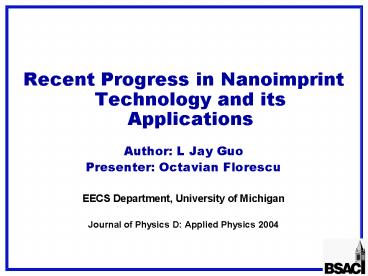Recent Progress in Nanoimprint Technology and its Applications PowerPoint PPT Presentation
Title: Recent Progress in Nanoimprint Technology and its Applications
1
- Recent Progress in Nanoimprint Technology and its
Applications - Author L Jay Guo
- Presenter Octavian Florescu
- EECS Department, University of Michigan
- Journal of Physics D Applied Physics 2004
2
Outline
- Motivation for NanoImprint Lithography (NIL) in
biological applications - NIL used in various blocks intended for
bio-applications - Analyte Manipulation
- Analyte Separation
- Analyte Detection
- Conclusions
3
Motivation What is appealing about NIL for bio
applications?
- Cost
- Biosensors are often disposable
- Resolution
- In some cases the biosensor sensitivity depends
on minimum feature size - Novel structures
- Enables more/different applications than
traditional photolithography
4
Analyte Manipulation Microfluidics
- NIL enables sealed channels with predictable
dimensions - Cost effective
Guo L J, Cheng X and Chou C F 2004 Nano Lett. 4 69
5
Analyte Separation
- Electrophoresis
- Capillary effect due to the nano pillars emulates
a high viscosity gel
Pepin et al., Microelectronic Engineering 6162
(2002)
6
Analyte Separation
- Filters
- Generated by multi-level reverse nanoimprinting
Bao L R et al., 2002 J. Vac. Sci. Technol. B 20
2881
7
Analyte Separation
- Protein patterning
- NIL in conjunction with lift-off to define areas
coated with functional protein
Falconnet et al., Nano Letters 2004
8
Analyte Detection
- Electrochemical transducers
- Nano particles/ molecules between electrodes
change conductance (i.e. redox cycling) - Smaller inter-electrode distance can improve
sensitivity
Vieu et al., LITHO2004, June 2004, Beck et al.,
Microelectronic Engineering 7374 (2004)
9
Analyte Detection
- Cantilever
- Nanoparticles/molecules can change cantilever
properties - Smaller cantilevers can detect single binding
events
Luo et al., Nanotechnology 17 (2006) 19061910
10
Conclusions
- NIL is remarkably well suited for bio
applications - Low cost
- Versatile
- One of the main stumbling blocks for bio
applications is separation of analytes - NIL is a potential cost effective solution
11
Thank you!
PowerShow.com is a leading presentation sharing website. It has millions of presentations already uploaded and available with 1,000s more being uploaded by its users every day. Whatever your area of interest, here you’ll be able to find and view presentations you’ll love and possibly download. And, best of all, it is completely free and easy to use.
You might even have a presentation you’d like to share with others. If so, just upload it to PowerShow.com. We’ll convert it to an HTML5 slideshow that includes all the media types you’ve already added: audio, video, music, pictures, animations and transition effects. Then you can share it with your target audience as well as PowerShow.com’s millions of monthly visitors. And, again, it’s all free.
About the Developers
PowerShow.com is brought to you by CrystalGraphics, the award-winning developer and market-leading publisher of rich-media enhancement products for presentations. Our product offerings include millions of PowerPoint templates, diagrams, animated 3D characters and more.

